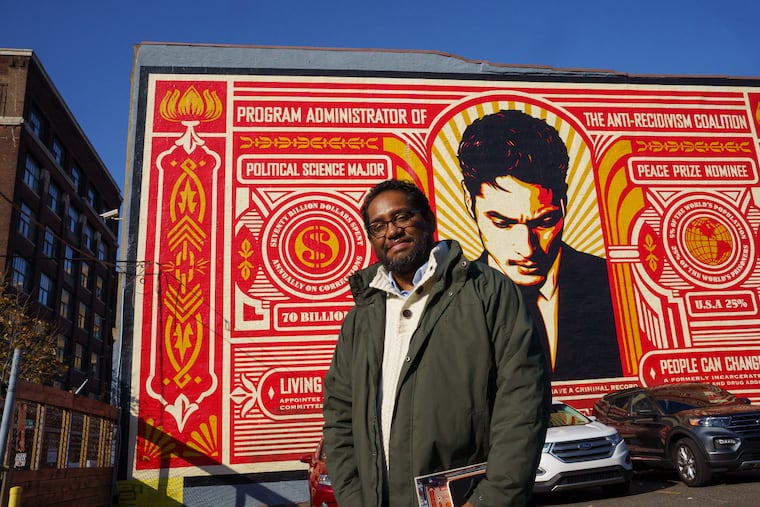He spent 27 years in prison making murals he’d never see finished. Now, he’s the Philly DA’s artist-in-residence.
"The connection between the reforms we’re trying to make in Philadelphia and the people in Philly who are part of that movement are best made in some ways through the arts," DA Larry Krasner said.

For nearly two decades, James Hough painted sections of murals that would splash color, bold imagery, and messages of resilience, healing and hope across more than 50 blank or blighted walls across Philadelphia.
But Hough — who was serving a life sentence at the State Correctional Institution-Graterford — never saw the finished artwork. Each square of parachute cloth he painted was sent out into the world. He saw the finished product only in photographs sent to him by Mural Arts Philadelphia’s Restorative Justice program.
Then, the U.S. Supreme Court ruled that life sentences automatically imposed on minors were cruel and unusual, putting Hough in line for a new sentence making him eligible for parole.
Now, Hough is seeing his work on display for the first time — and expanding his role in making public art as an unlikely emissary for the Philadelphia District Attorney’s Office, where he is taking a position that’s been described as the first-ever artist-in-residence at a DA’s office, embedded alongside prosecutors, investigators and victim advocates.
Philadelphia has seen artist residencies in a high-poverty neighborhood, an environmental education center and even a dump. But a DA’s office where prosecutors are busy handling sensitive and serious matters?
It makes perfect sense to DA Larry Krasner, who sees the arts as central to the criminal justice reform movement, starting with the writing of Michelle Alexander and continuing with the films of Ava DuVernay, right up to Kendrick Lamar’s songs of racial injustice.
“We’re seeing this bona fide cultural moment, and the arts are an integral part of it," he said. "And the connection between the reforms we’re trying to make in Philadelphia and the people in Philly who are part of that movement are best made in some ways through the arts.”
He also sees art as a means of communicating with the public, making the office more accessible.
“It’s not advertising. It’s not propaganda. It’s not going to be closely controlled," he said. "It’s going to do the powerful things that art can do.”
Plus, he emphasized, no taxpayer funding will be used.
Instead, the project will be supported by Mural Arts Philadelphia and by Fair and Just Prosecution, the national network of reform prosecutors. The two jointly sought a grant from the Art for Justice fund.
Installing an artist-in-residence in a city agency is a first for Philadelphia, but was inspired by initiatives in other cities, such as a Minneapolis effort that brought artists into departments including streets and licenses and inspections, Mural Arts’ executive director Jane Golden said.
Miriam Krinsky, who heads Fair and Just Prosecution, sees the project as a pilot for other offices around the country willing to welcome in artists and work with them to humanize the impact of the system and underscore the need for reform.
She acknowledged that by bringing in someone such as Hough, who came into the criminal justice system at 17 for fatally shooting a man on a Pittsburgh street in 1992 and spent 27 years in prison, the work is also squarely aimed at those who work within the office.
Hough, who lives in Pittsburgh, envisions conducting interviews and workshops with DA office staffers and people in the community, and using those testimonials to inspire a series of videos and paintings. But until he begins the 10-month assignment, it’s hard to say what the finished project might look like.
On Thursday, before a news conference at the District Attorney’s Office to announce his new role, Hough stopped off near 12th and Callowhill Streets, to gaze up at a striking mural he’d created called the Stamp of Incarceration, working side by side with the artist Shepard Fairey and other prisoners.
“I was involved with this mural for the whole process: developing the concept, mixing the colors," he said. "Now, the final step is witnessing it.”
To Hough, seeing this work in the world for the first time felt surreal — and profound.
“I can’t wait for some of the other guys that are incarcerated to get that experience,” he said. “It really places you as an individual who worked on a collective project in the bigger scheme of things, in the sense that you contributed to the tapestry of the city in a meaningful way. And it opens the door to the possibility that there’s more that you can do.”